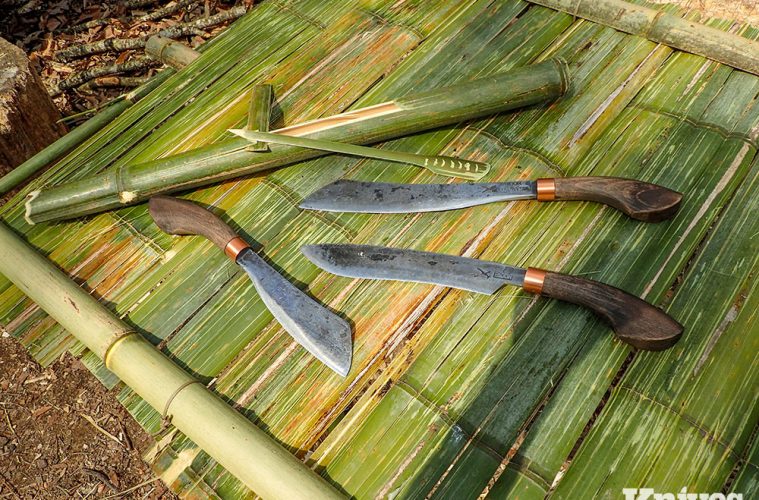IMPROVISE EVERYTHING YOU NEED WITH THESE AUTHENTIC MALAYSIAN LONG BLADES (PARANGS)
Years ago, I took a trip to Malaysia in search of adventure and authentic Malaysian parangs. I found both and made a good friend along the way.
CHANGE OF PLANS
The plan: Travel to Malaysia and make my way up through Thailand before moving on to Cambodia. Through a series of emails, I found a guy named Ahmad Nadir (of My Parang) in Penang, Malaysia, which was where I made sure to end up, despite my former plans.
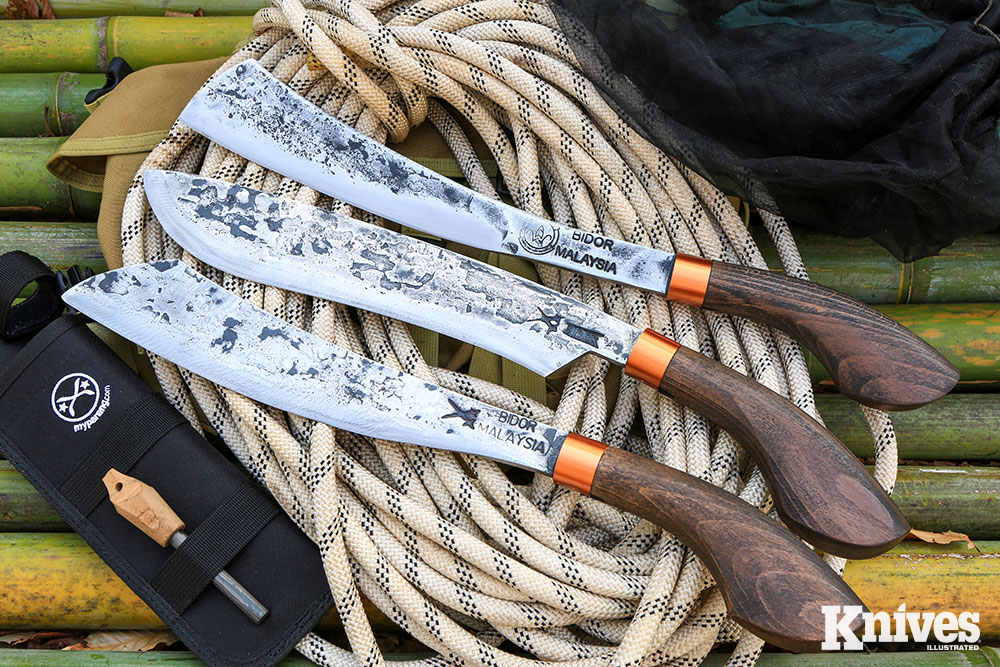
My Parang Lading, Golok 135, Duku Chandong (top to bottom) knives. The perfect manual “power tools” for adventures abroad or in the backyard.
I met Nadir in the morning, and he took me on a road trip a couple of hours north to Perak, where the parangs are made by the legendary Bidor blacksmiths, world-renowned for their differentially hand-hardened 5160 steel. It was a small factory with an equally small showroom featuring a variety of parangs and tools. The work area was quite large with about four work stations, each with furnaces and automatic hammering machines.
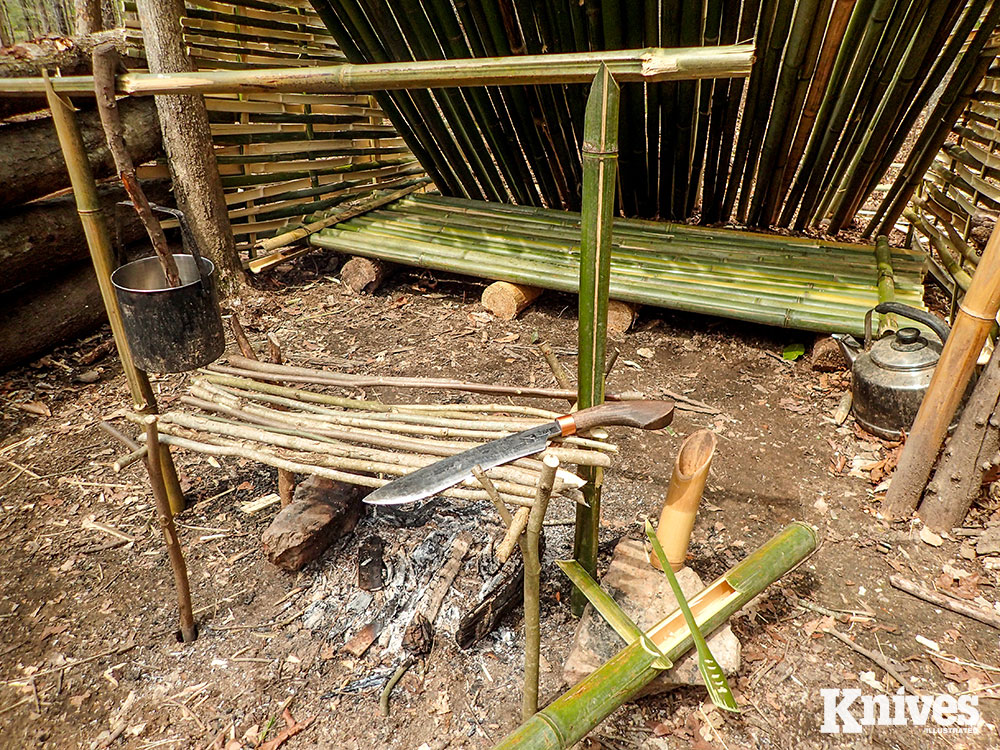
A bamboo jungle kitchen equipped with a swamp grill, rice maker, spatulas, and a hanging system to suspend pots was made with the Golok 135. It sliced, carved, hammered, chopped, and pried wood/bamboo. This is exactly the type of work suited for parangs.
This was a more upscale forge than I’ve been to in other countries, the type of mini-production factory that can supply more blades than the traditional way of hand forging one at a time. Think of it as a way of commercializing a traditional tool full of history without sacrificing its design and heritage.
WHAT IS MY PARANG?
Simply put, My Parang exports parangs made in Malaysia. Every one of them has a hammered 5160 high carbon steel blade with a stick tang that is fitted with a large, comfortably contoured beechwood handle. Reinforcing the tang and handle is a brass pin and industrial strength epoxy along with a polished copper collar. While the blades are made in Bidor, Perak, the eco-friendly wooden handles are imported from Croatia. Each parang includes a heavy-duty nylon sheath.
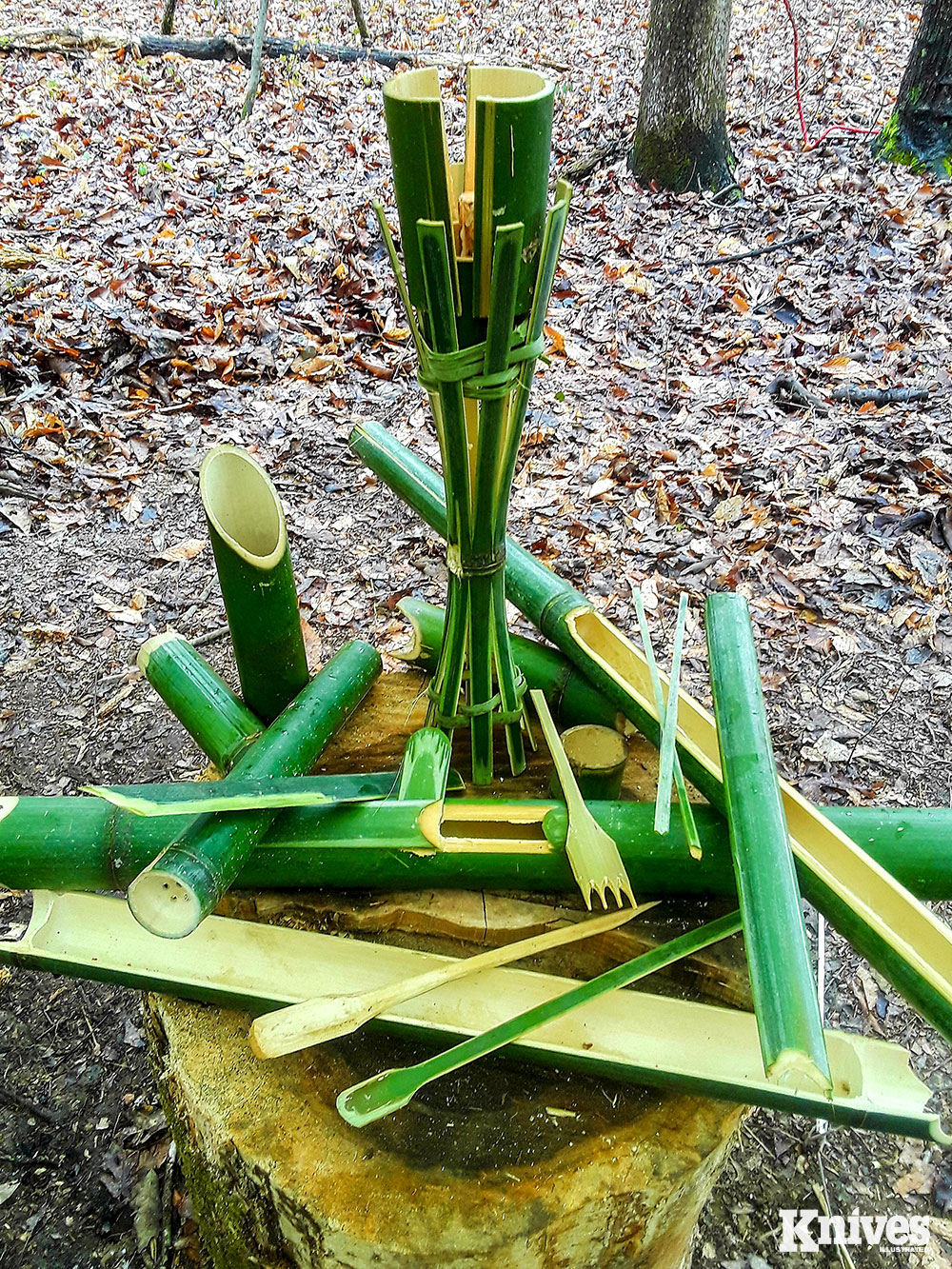
Some of the camp implements made and used by the author and Patrick Rollins during their camp building include an array of cups, boiling and steaming containers, spatulas, and more.
A distal taper is standard on parangs, period. According to My Parang, “This improves the balance of the parang, making it very lively and quick in the hand without sacrificing chopping power. A distal taper is very difficult and expensive to achieve with a factory-made knife or custom knifemaker.”
ICONIC PARANG
The Duku Chandong is a very common knife in Borneo, also known as Sabah and Sarawak. My Parang offers three sizes, featuring 8-, 10-, and 12-inch-long blades. I was sent the 8-inch and 12-inch versions. Duku means parang in the Iban language, so it means “Chandong parang.”
The Duku Chandong has the general shape of the iconic Malaysian parang made popular by survival and bushcraft authorities throughout the years, such as John “Lofty” Wiseman and Ray Mears. However, because these are usually made in small blacksmith shops, there is no one pattern. The hump can be rounder or more neutral, the same as the degree of curve/sweep of the blade.
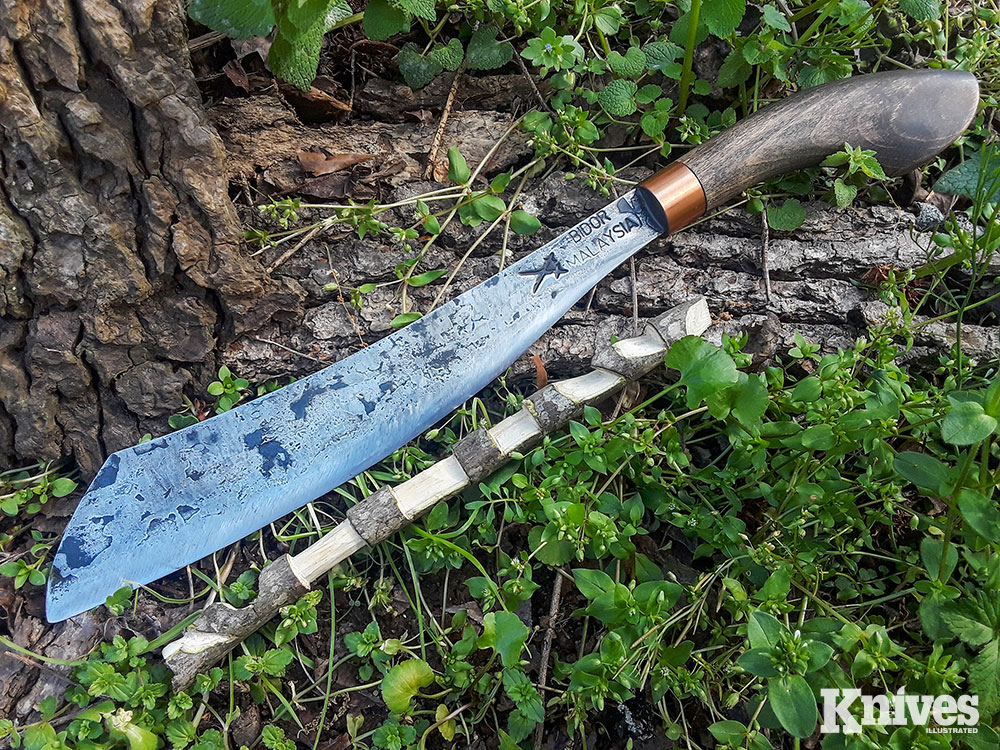
In a display of fine Bushcraft work done with a larger blade, the Duku Chandong made a try stick on a small branch.
Arguably, the Duku Chandong has the most all-purpose parang shape. It has a sheepsfoot blade tip, not pointed like other traditional parangs and goloks. The tip needs to be strong to split and flatten bamboo, as well as for prying or digging into wood. It chops vegetation, and slices food superbly.
The Duku Chandong sliced meat for the grill along with onions, peppers, tomatoes, and squash. The 12-inch length made cutting a large spaghetti squash easy with the help of a baton, easily cleaving it in half lengthwise.
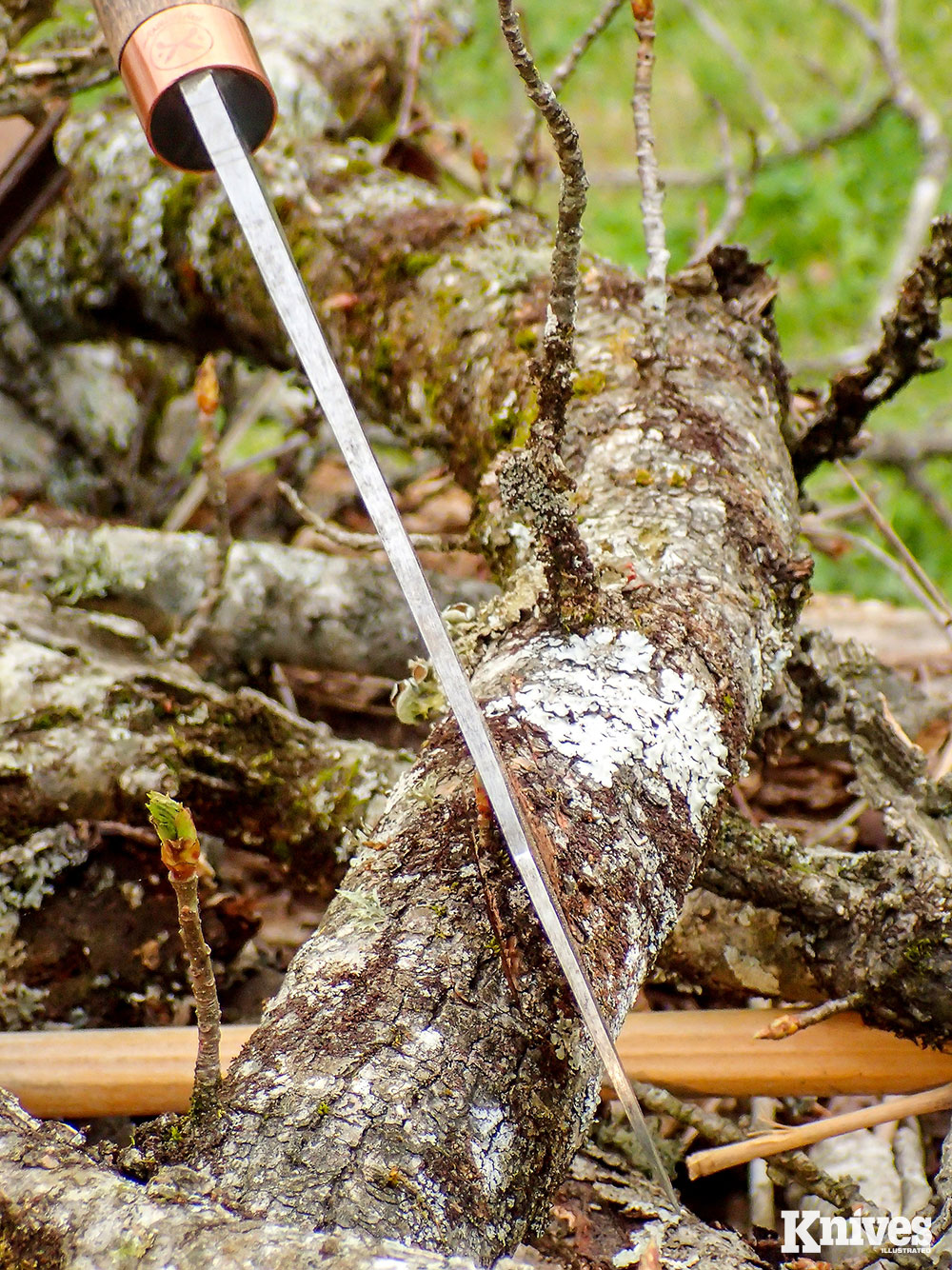
My Parang puts a distal taper on their blades, which makes them have that authentic feel in the hand. This is where every USA-Made knife company gets it wrong: bypassing this detail, thus making the tool way too cumbersome.
The Duku did fine work, like prepping wood for fire, easily by choking up on the unsharpened portion of the blade, which put the knife closer to the feel of a medium fixed blade. Like most parangs, the sharpened portion of the blade is about one-half to two-thirds from the handle, allowing versatility to the tool. This means short, controlled chops and slices can be used by gripping the blade closer to the action.
However, by inverting the parang so the tip points down with the edge facing away, fine curls can be produced quickly and precisely as the wood is drawn back against the cutting edge. This is a more proficient yet often overlooked way to produce thin shavings for tinder and grassblade-sized kindling pieces.
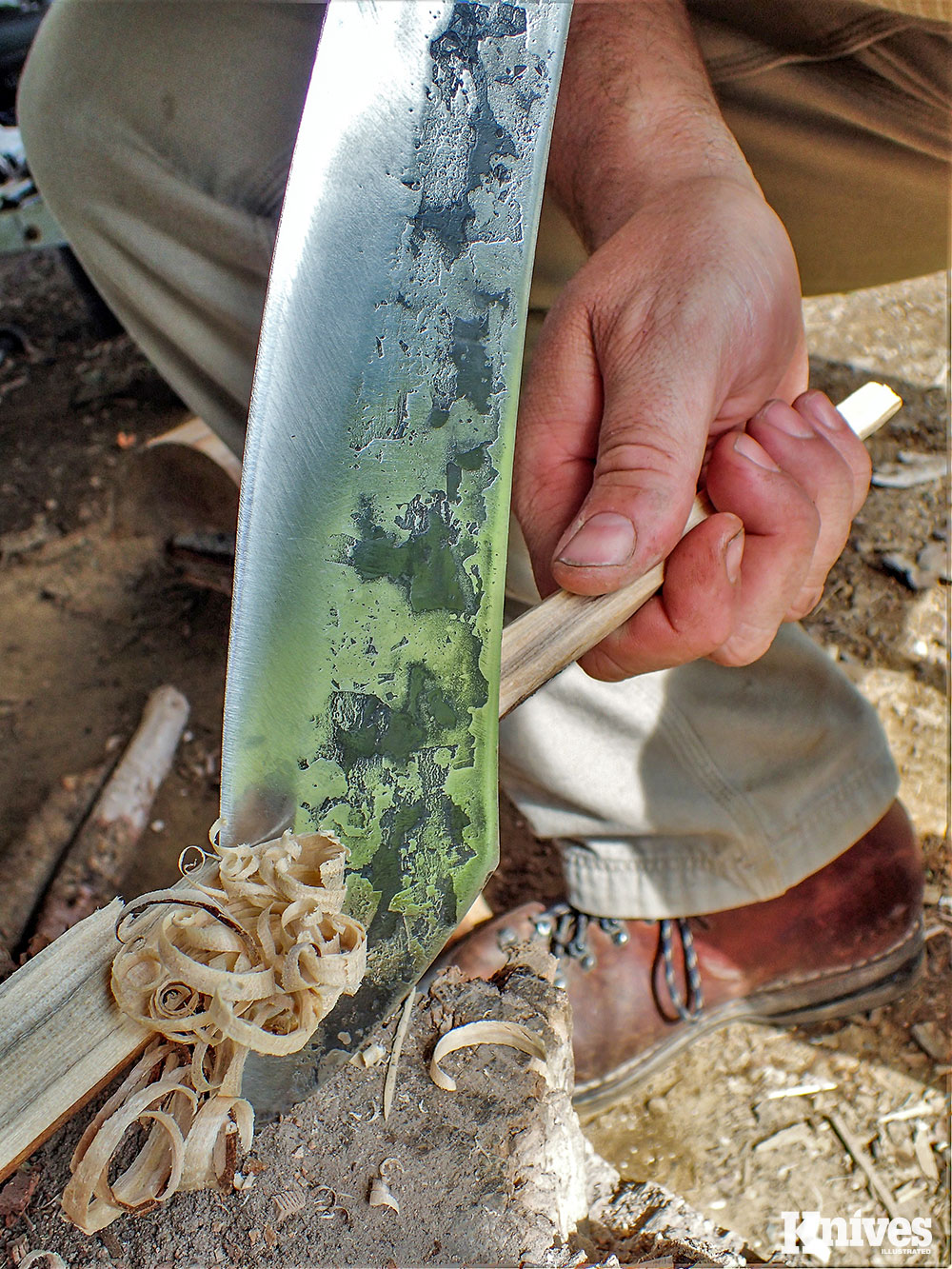
The Duku Chandong has a large fixed-blade feel making it well suitable for carving and fine work. Here it made feather sticks for some much-needed grilling. The handle is designed so the user chokes up high on it.
By utilizing the parang when choked up on the blade, all aspects of bushcraft are the same, especially when making ground stakes where chamfering the ends is important. This grip makes the long-bladed tool feel less cumbersome. A try stick was made with the 12-inch long Duku Chandong as if it were a smaller knife.
When it comes to chopping and splitting, let’s just say the Duku Chandong fights out of its weight class. It took down a sizable dead poplar tree in a matter of minutes, without any handle or edge damage. It chopped and split firewood and kindling for a cook fire, and split bamboo for skewers, poles, and other camp necessities.
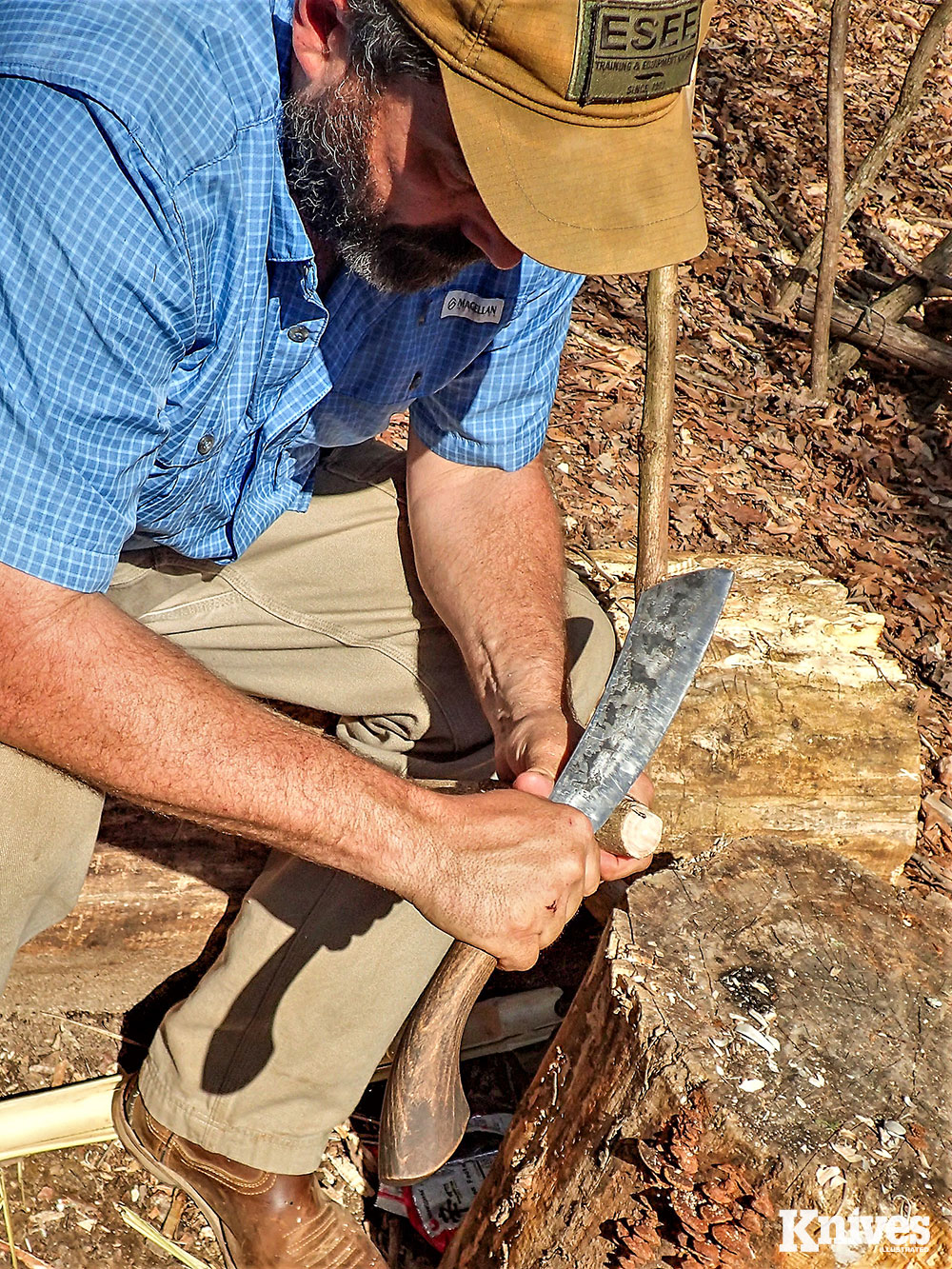
The parang used by Patrick Rollins (Randall’s Adventure & Training’s Lead Instructor) for making greenwood stakes. This section of any long blade has the most control and remains sharper than the chopping portion. Choke up on the blade like a conventional fixed blade knife.
It tag-teamed with another parang sharing the arduous task of splitting long bamboo poles for the bamboo camp. A baton was used to make the splits with the Duku, and after days performing this task, there was never any handle play on this stick tang workhorse.
The bamboo table was another job where the blade shape of the parangs truly shined. Making a bamboo mat or tabletop requires a technique to flatten the shoots. By carefully holding the bamboo, several short, quick chops were made in the fibers parallel with the tip of the parangs, making sure none of the splits line up. This weakens the bamboo and makes it pliable.
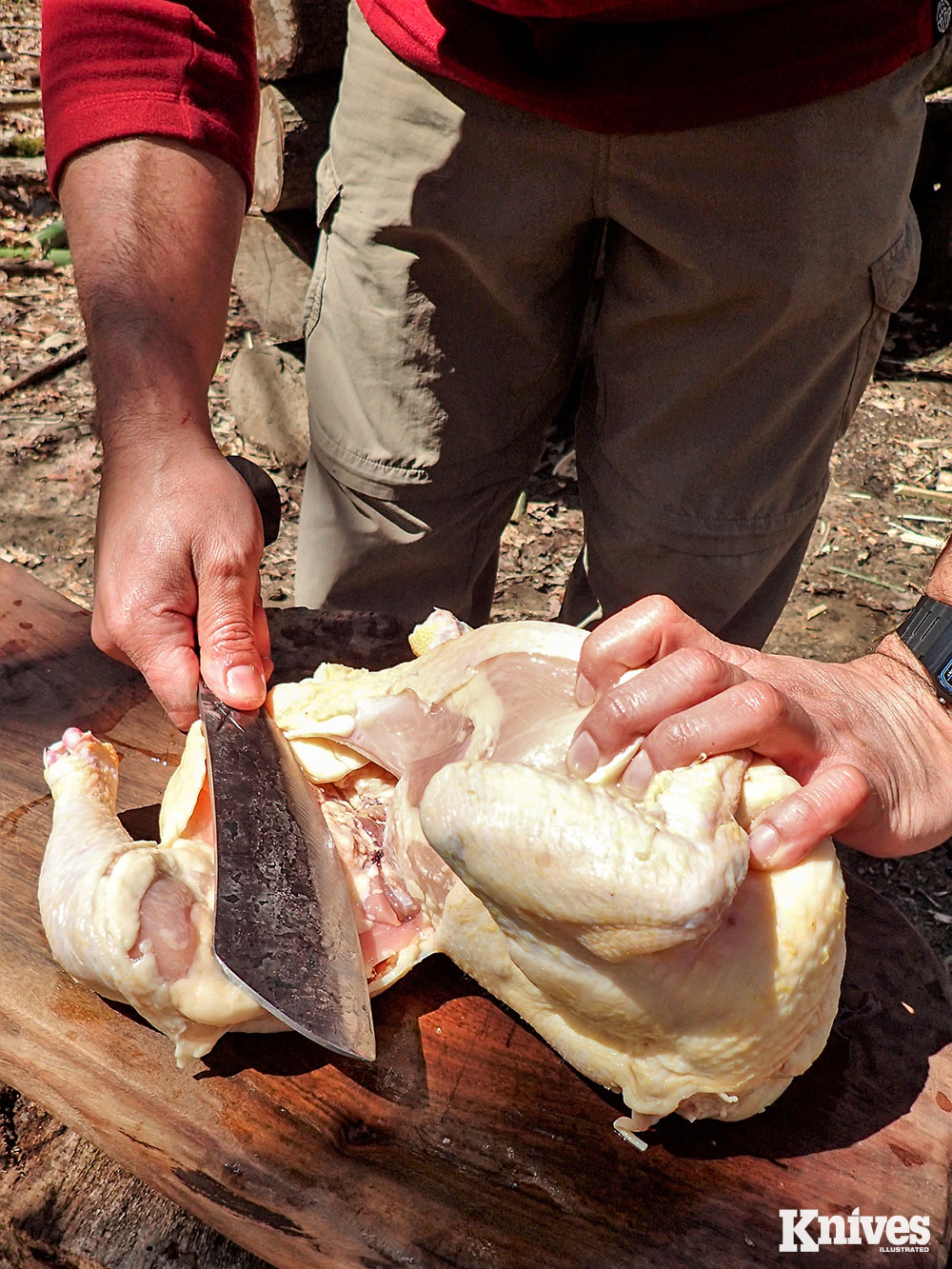
The author quartered a whole chicken for the grill using the 12- inch Duku Chandong like he would a cleaver. The blade was up to the task and the handle was comfortable to choke up on.
The sheepsfoot blade seemed perfect for this task as it naturally dug into the bamboo. Once the bamboo seemed pliable, one decisive cut was made, opening the bamboo up. The section where the nodes were had to be trimmed, minimizing their thickness to make them easier to flatten. This is the type of work that parangs have been doing in Malaysia as long as parangs have been around.
TRADITIONAL MALAYSIAN
The Lading parang is used as a weapon in the Silat Cekak traditional Malaysian martial arts and as an agricultural tool, although there are some slight differences between the everyday tool and the ones used in Silat Cekak. Having its roots in the Malay culture, the Lading is a popular, traditional parang design.
The Silat Cekak Lading needs to be made to match the arm of the owner. It is believed that a properly sized tool will not “bite” the user/owner if correctly made for them. This is very important, maybe not so in everyday use, but definitely during combat.
“The Duku did fine work like prepping wood for fire easily by choking up on the unsharpened portion of the blade…”
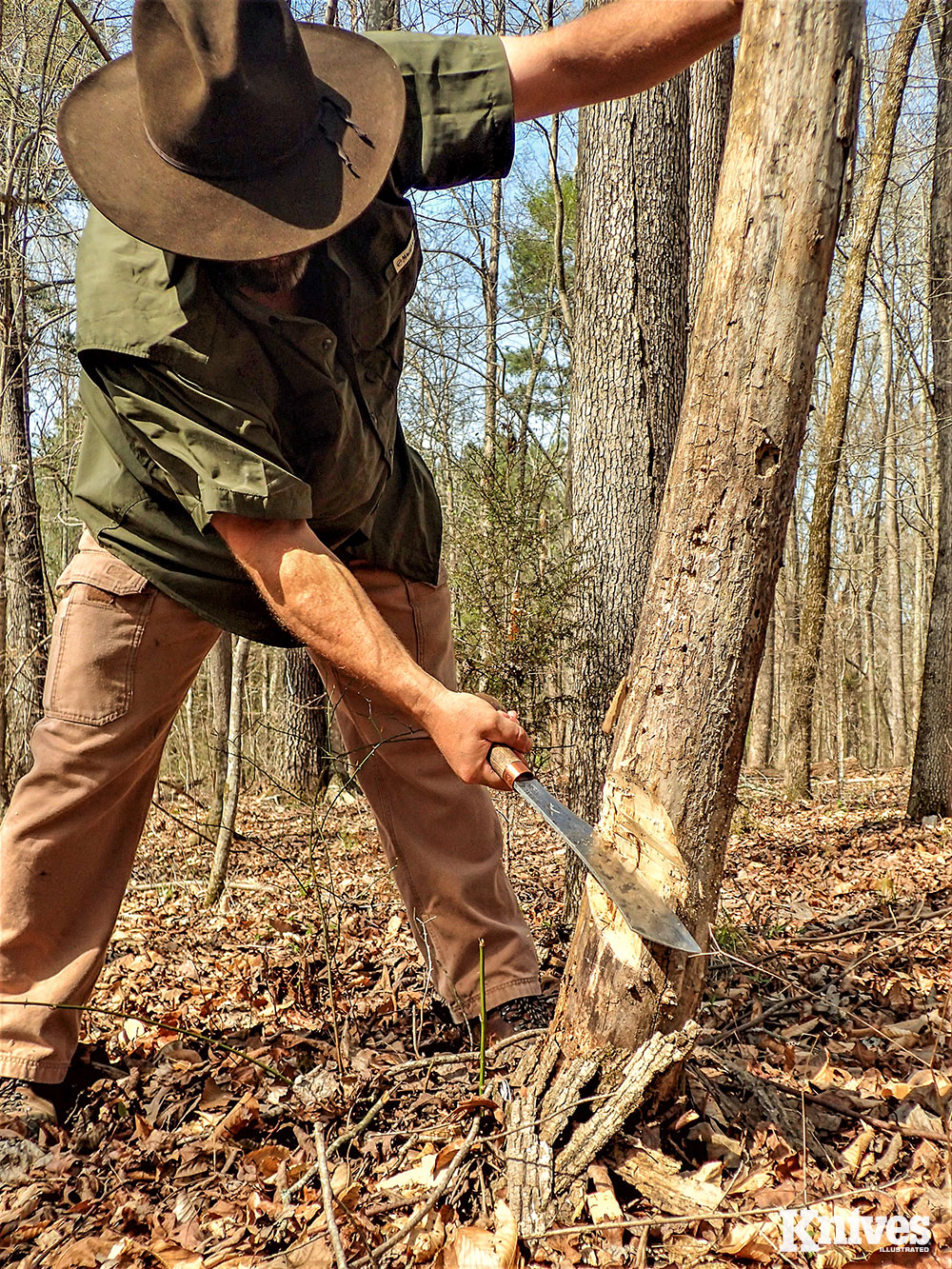
Patrick Rollins (Randall’s Adventure & Training’s Lead Instructor) chopped down a sizeable poplar tree with the Duku Chandong. My Parang blades are definitely more than capable of punching out of their weight class.
Another difference is that the Lading used in Silat Cekak is usually only sharp about 1-2 inches from the tip. This is done so the un-sharpened part of the blade is used to stop or deflect the strike of the opponent.
The agricultural version has perhaps 8-10 inches of sharpened edge on a 12-inch long blade, while the My Parang Lading has 7 inches of cutting edge (and 5 inches unsharpened blade). This gives an advantage when it comes to choking up on the blade for finer tasks such as splitting rattan/bamboo and carving.
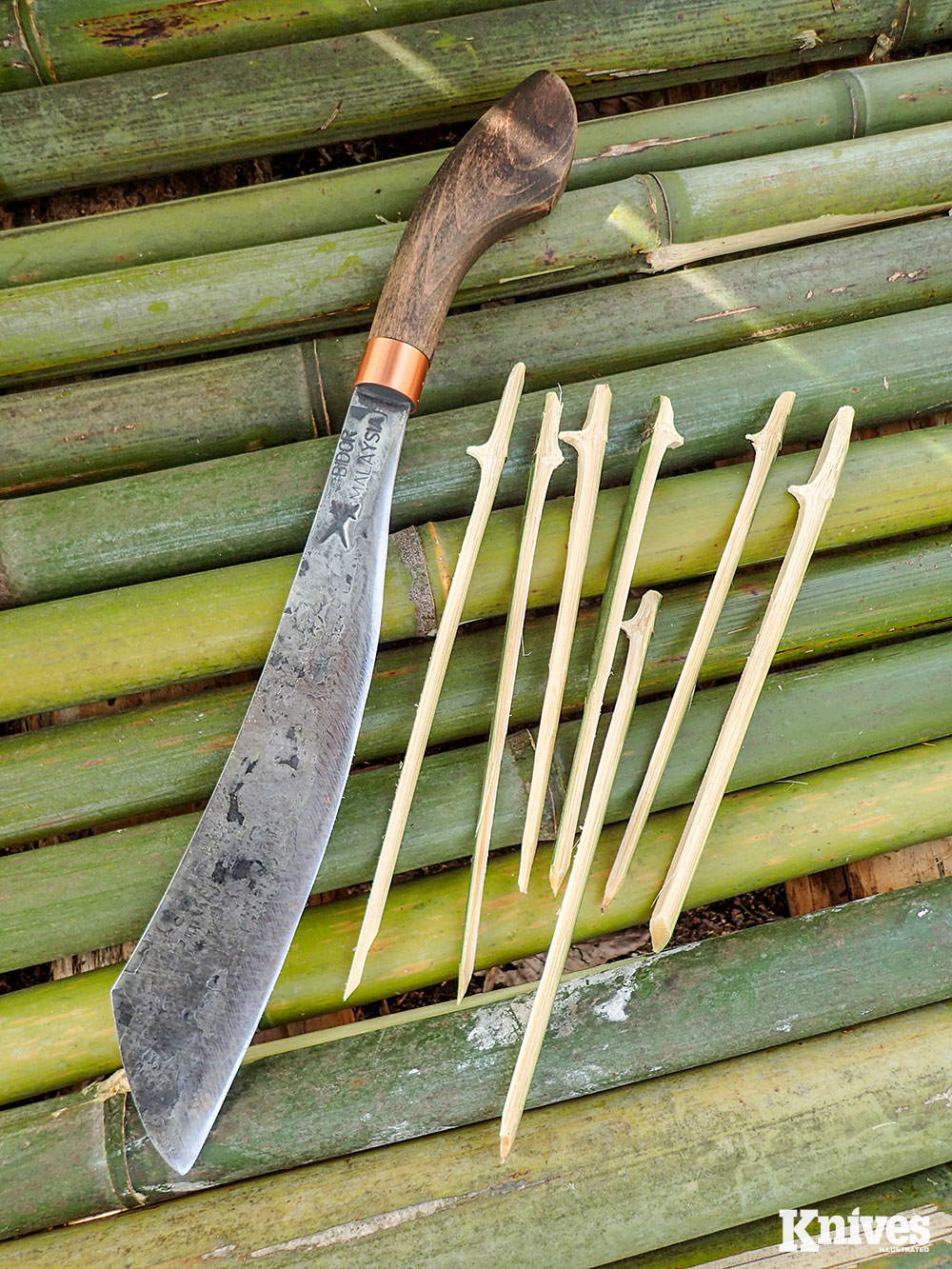
Bamboo skewers were easily made with the Duku Chandong using a section close to the nodes of the bamboo. This allows food to stay on the skewer and not slip off while holding upright.
I instantly gravitated towards the more, squared-off tip than the sheepsfoot Duku Chandong, and the Golok. There is more meat towards the front, which makes it heavier than the Duku and perhaps a bit less curvy. I used this as my bamboo and wood chopper for making kindling and cutting fuel-sized pieces of wood. Choking way back on the handle allows for maximum power, while the handle stays confidently in the hand.
Perhaps the largest undertaking with the Lading was making a bamboo shelter where numerous 7-foot-long bamboo poles were split with the parangs. This was easily done by chopping or batoning the blade into the top of the bamboo. Then with one hand on the handle, and the other on the front of the spine, I pulled the blade down in a rocking motion to split it through the nodes. This action was done fast and vigorously to snap the bamboo in two.
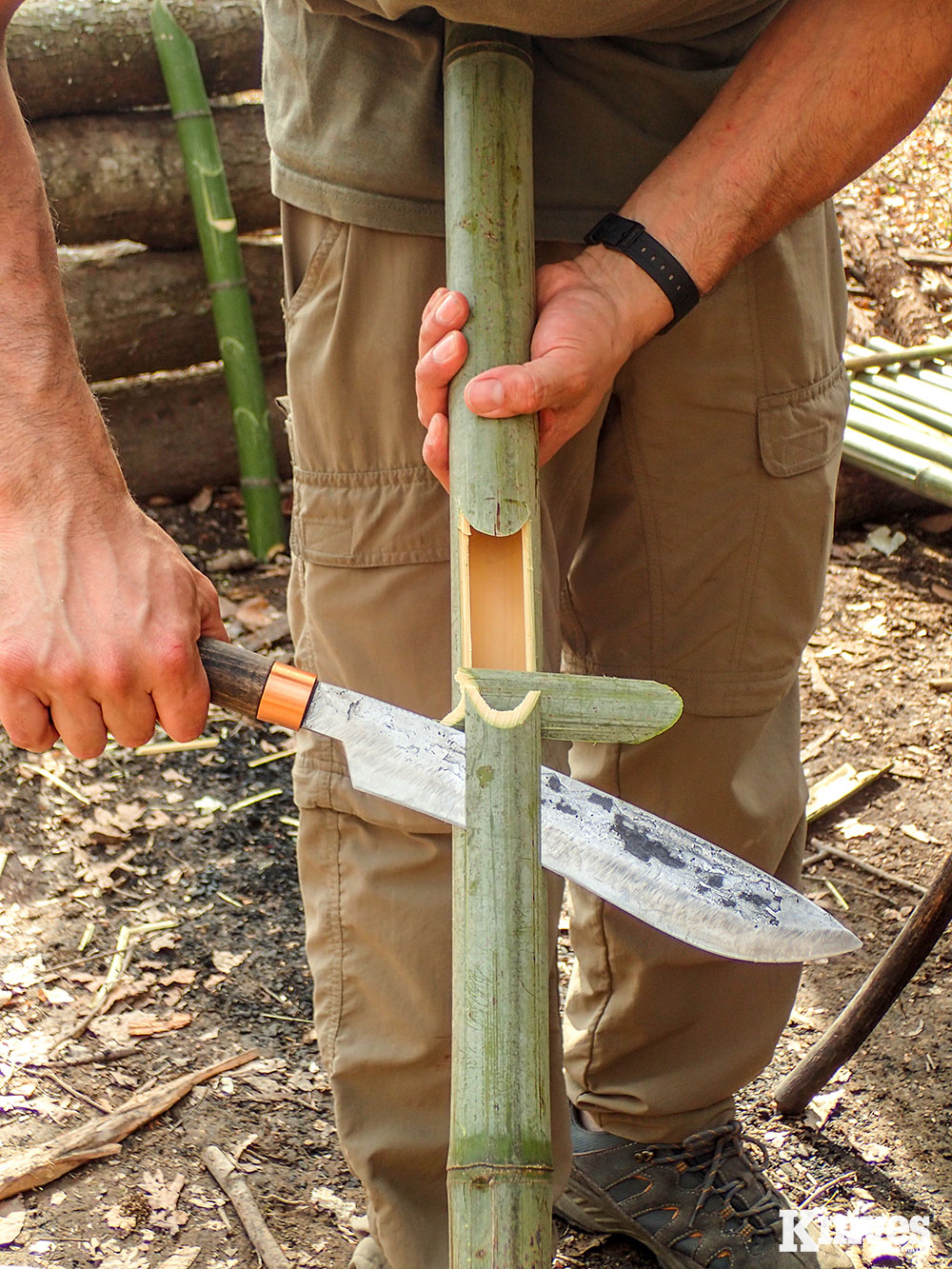
The author made a rice maker with the Golok 135 on some thin-walled, green bamboo. This is a jungle-style rice maker from jungle survival training in the Philippines and requires a sharp blade.
The squared, weighty tip worked well as a hammer when the parang was turned around to knock out the nodes on the inside of the bamboo. Some bamboo splits were further split into more narrow pieces to construct a bamboo wall for the bamboo lean-to. The Lading made utensils for eating rice and poking meat as well as made a rice cooker out of bamboo.
GOLOK 135
In West Malaysia and Indonesia, the golok is a very common design. Even as far up as the southern tip of the Philippines, the influence of the golok can be seen. Easily standing out as the black sheep of the parangs offered by My Parang, the golok has a recurved blade and a large belly leading up to a sharp point.
The tip is pretty strong and the point makes it easy to dig and drill holes. My Parang offers four different golok-style parangs (115, 120, 125, and 135). Apparently, these numbers are somewhat universally known throughout Malaysia. A Golok 135 bought in different states will be the same design and same length and weight.
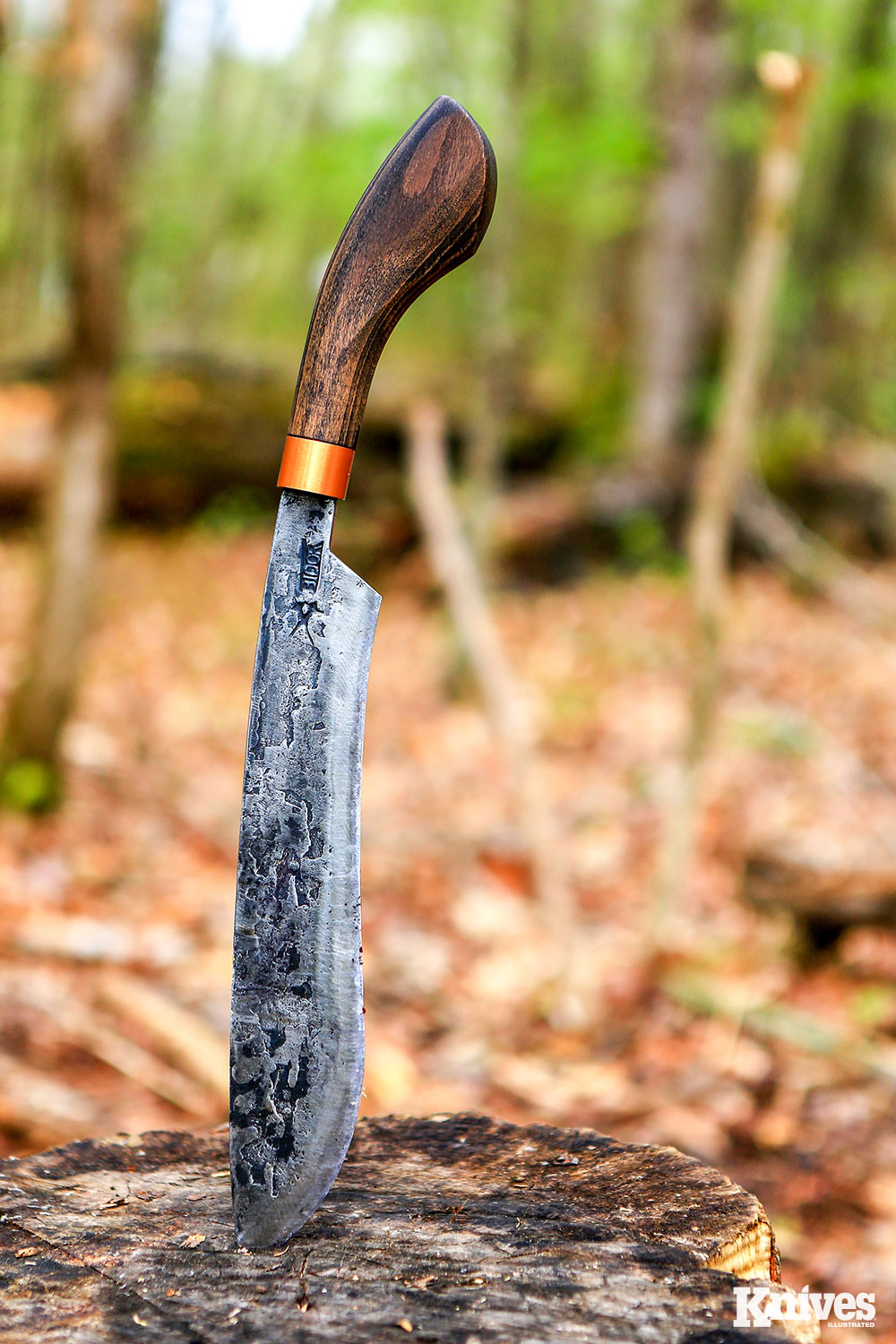
The My Parang Golok 135 has a 12 inch-long blade with 11 inches of cutting edge. 5160carbon steel on a 6.5 inch-long Eco Beech handle, with a copper sleeve over a single brass pin
By far the heaviest of the three choppers from My Parang was the Golok 135 model. It sported a 12.25-inch long blade and an overall length of 18.75-inches long. This blade has more of a weight-forward feel and look to it. The recurve edge has a way of naturally slicing as it is drawn back, increasing the cutting depth and power.
The widest point of the belly precedes the handle, resulting in a more powerful, penetrating chop. The golok knives also have less false edge area on the blade above the handle than parangs, which equals more cutting edge.
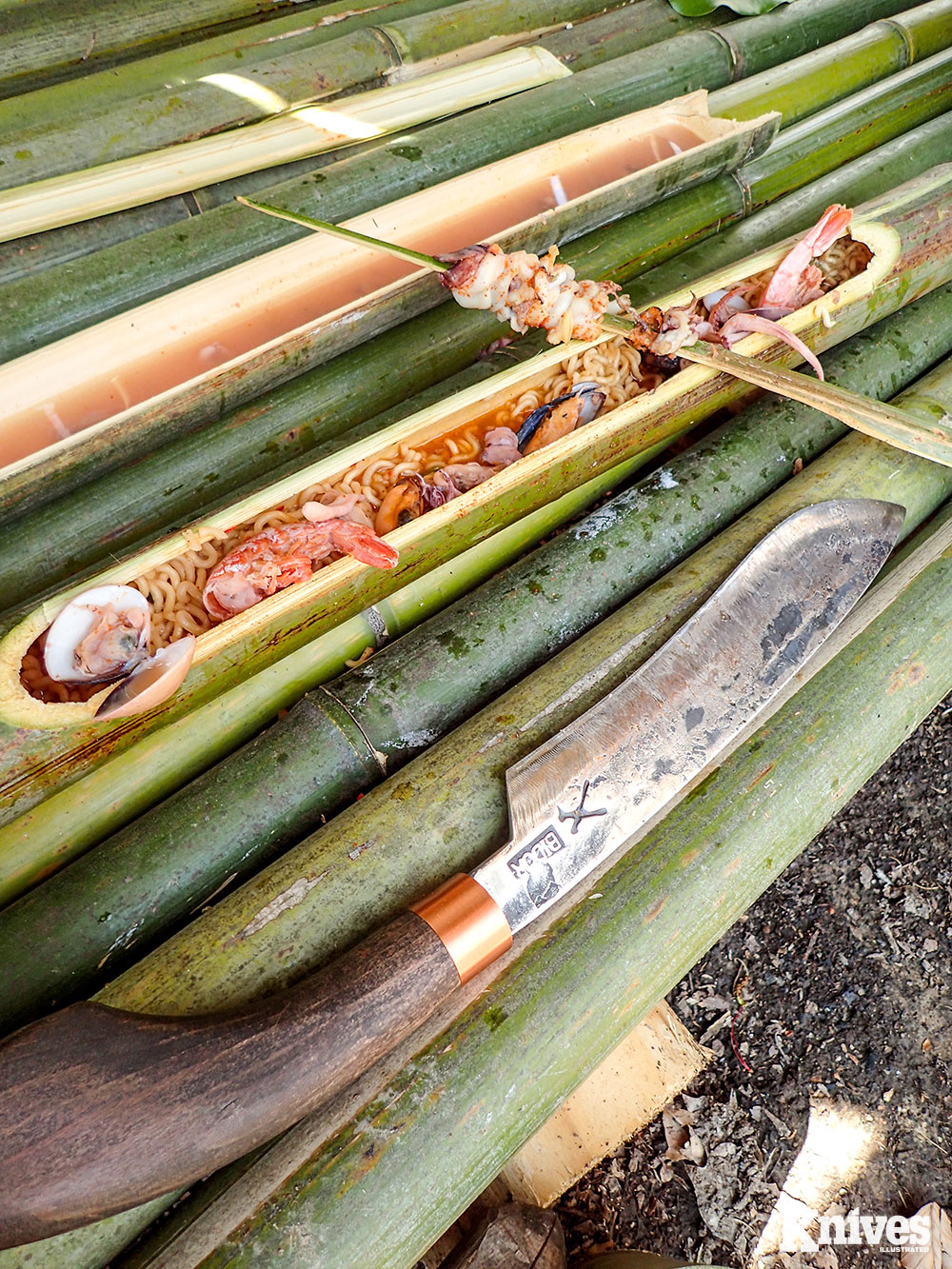
This piece of bamboo was chopped at each side to pry off the top for a cooking tube or serving platter. The bamboo spoon/utensil was used as a skewer.
This heavy golok is your chopper, splitter, and an all-around brute of a tool. To prove that, I first chopped into some thick, sweetgum branches. This helps with the feeling out process, finding the balance and sweet spot of the blade.
Being that the golok is on the thick, heavy side, I proceeded to split some hardwood for the grill. I split oak and hickory with the golok by chopping into the wood as I would with a tomahawk/axe, then used a baton to drive the blade through and complete the split.
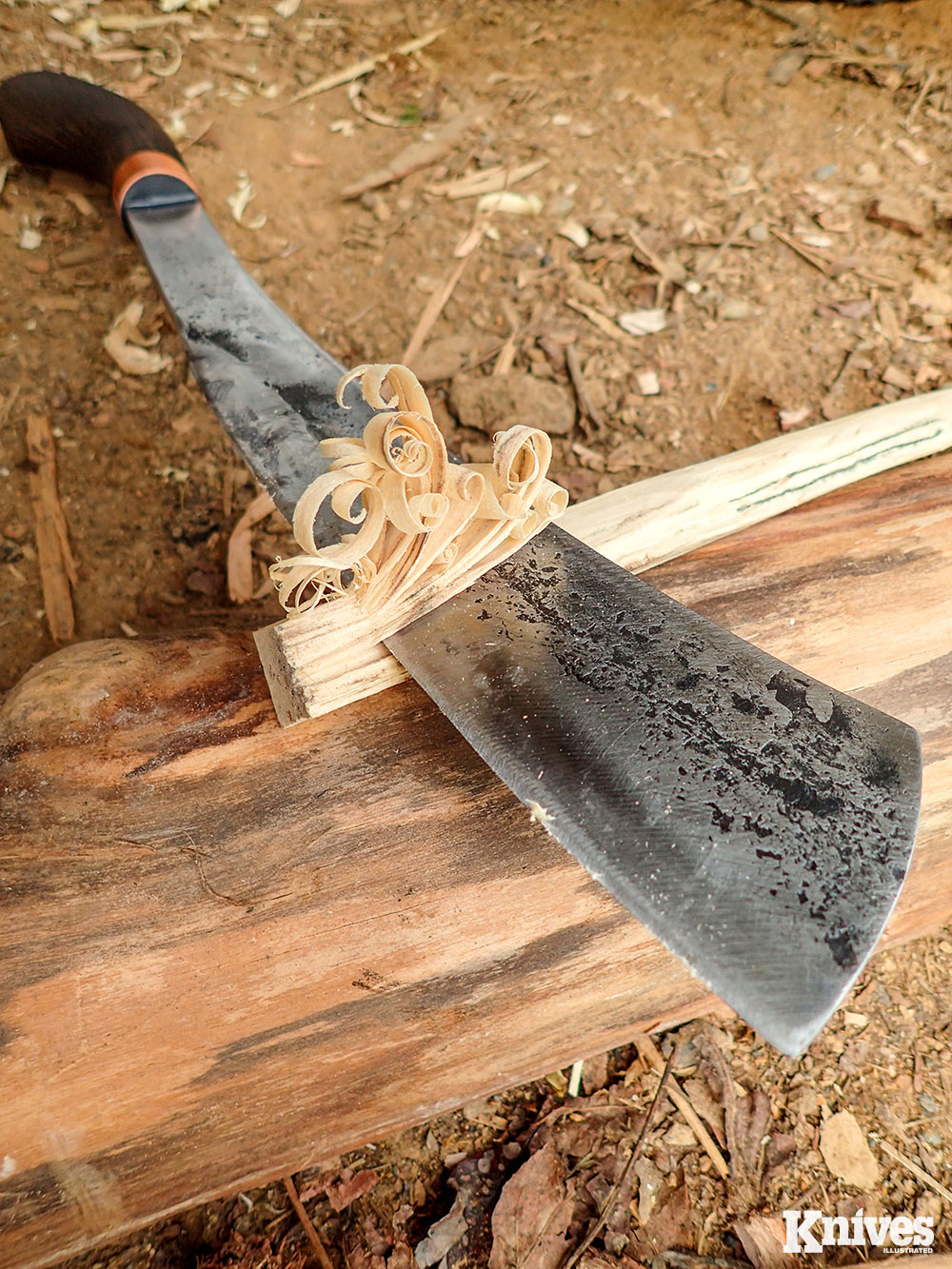
Choking up on the unsharpened portion of the blade allows for fine carving making tools or shaving feather sticks for a fire.
The 5160 carbon steel is considered a type of spring steel, perfect for high impact. Testing the limits of the Malaysian manufactured golok, I used a 16-pound sledgehammer as a baton on knotted hickory.
Bushcraft cooking in bamboo required two green, Y-sticks and two long lengths of green bamboo along with a pilot stick for the Y-sticks, which the golok provided. The green sticks were easily snipped off with the sweet spot of the golok, just on the inside bend of the belly.
“The Lading made utensils for eating rice and poking meat as well as made a rice cooker out of bamboo.”
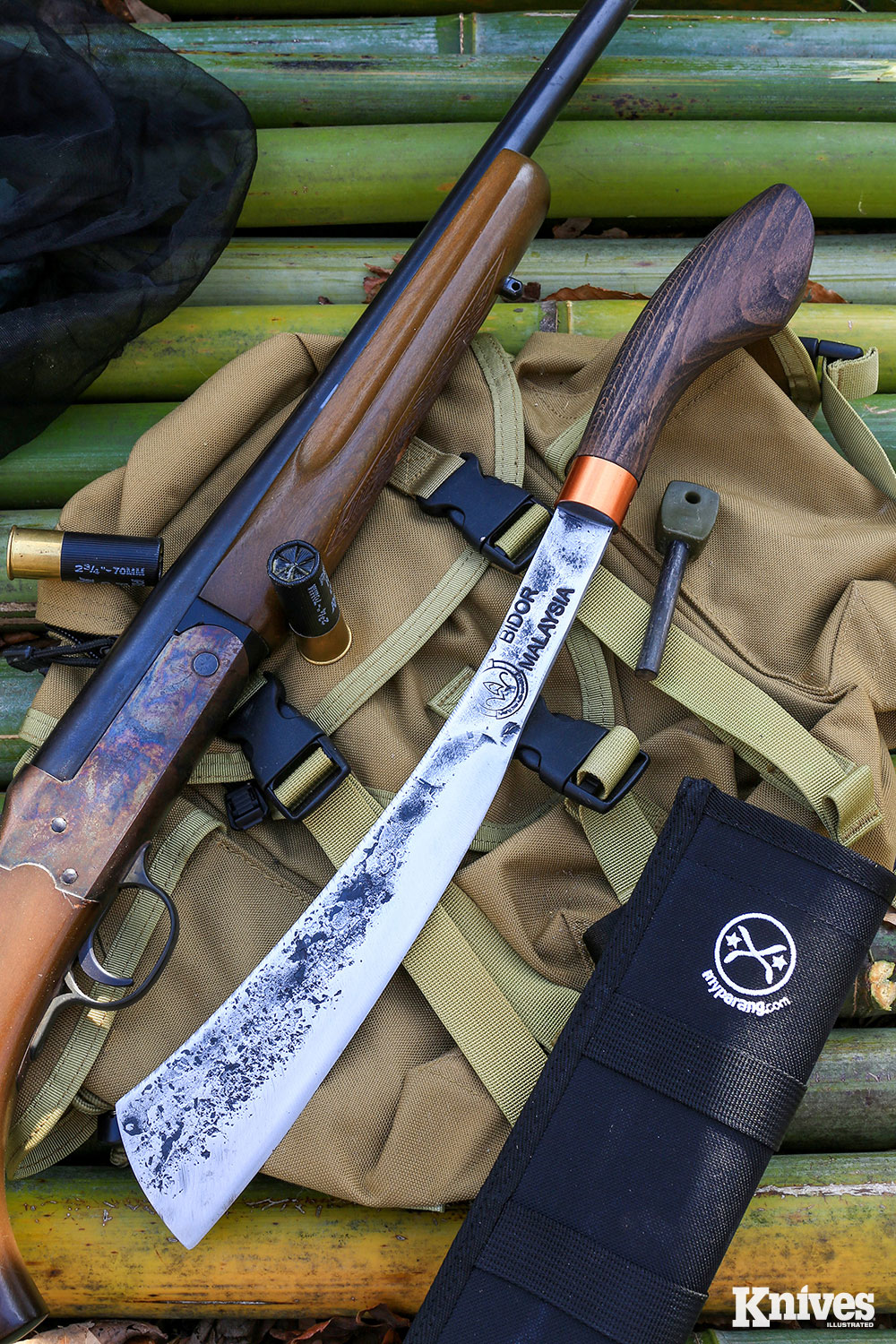
A more traditional parang, the Lading has deep roots in Malaysian martial arts and agricultural blades.
A stout, hardwood stick was cut and roughly sharpened to pound in the hard ground to dig pilot holes for the uprights. The golok was used as the hammer on the broadest part of the blade.
Next, one long length of bamboo was chopped in a fashion I learned in the jungles of the Philippines. I held the bamboo with my left hand as if I was going to throw it like a spear, elbow bent. My blade hand made four, short chops in the bamboo, close to a node, as my left hand rotated the bamboo. This gave me a clean cut with no splits resulting in a boiling container.
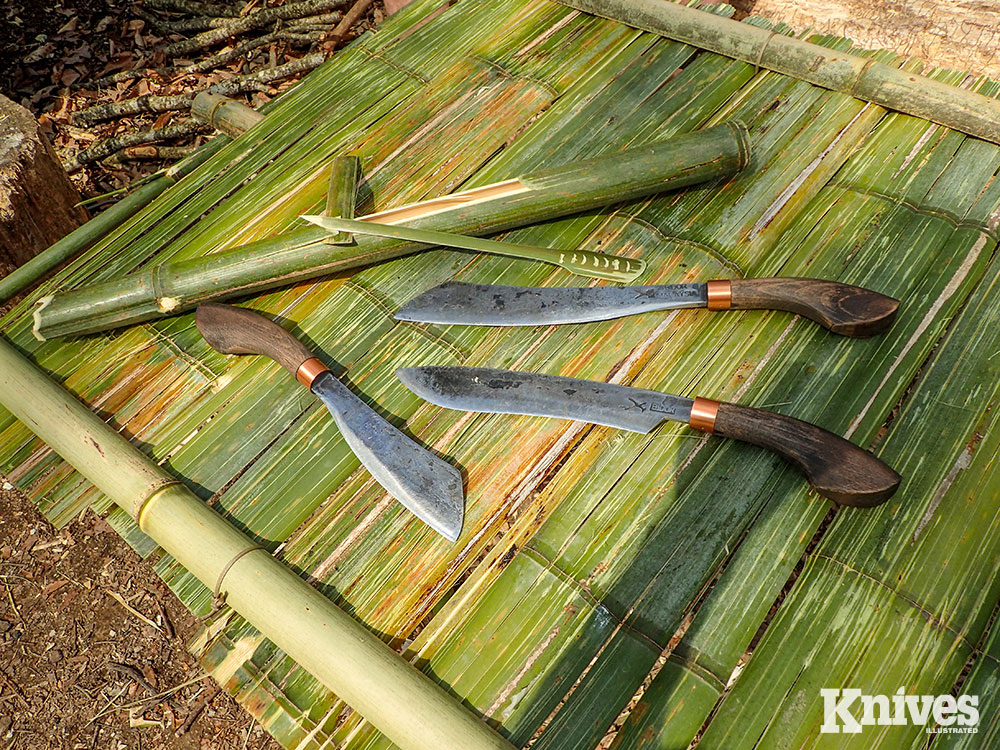
Completed bamboo tabletop and rice maker made with three parangs—the Golok 135 and Duku Chandong 12 and 8 inch-long blades.
The serving platter was another length of bamboo where I made two angled chops and used the point of the golok to stab into the sidewalls, prying the lid off. A small fire was made, with the golok responsible for chopping kindling and fuel. Seafood was boiled in the bamboo container and instant noodles were cooked with the hot water from the boiled seafood. I carved out a couple of quick bamboo spoons, and we were eating like kings.
GO AUTHENTIC
If you want to try out a parang, get a real one to ensure an authentic, realistic experience. My Parang offers goloks and parangs made in Malaysia. The parangs and golok performed incredibly well and remained comfortable in every grip. No loosening of the handle was experienced. The 5160 easily sharpened up on a puck/stone and strop. These were the real deal Malaysian parangs.
WHY A PARANG?
Parangs hail from the Malay Archipelago, a vast, oceanic, tropical region situated between the Indian and Pacific Oceans, which are home to over 25,000 islands including, Brunei, Singapore, Malaysia, Indonesia, Philippines and, East Timor.
The jungles of Southeast Asia and the Malay Archipelago are generally more “woody” than the jungles of Latin America. The parang and golok is designed for stronger chopping, which is why the parang blade is heavier than machetes, and with a broader bevel angle to prevent binding
in the wood when chopping.
EXPOSING A PARANG FALLACY
The “SAS Survival Handbook” by John “Lofty” Wiseman has been a favorite of mine for years. Under the description of a parang, Lofty mentions the three different edges on a parang and how the different edges are used. The book explains that the grind towards the tip is extra sharp for skinning and scraping work when preparing game.
The middle section is used for the heavy chopping like an axe, and near the handle is perfect for feathering sticks, bark stripping, whittling, and food preparation. This information also appears in videos people have made and posted online about their parangs.
After owning and using quite a few, I have yet to see three different edges or grinds on a parang. I asked Nadir about this, considering he has been around parangs his entire life. He hasn’t ever seen or owned a parang made with such specifications. However, there are custom makers who may be doing this, but traditional parang makers do not take the time to make three different grinds. Myth busted!
SPECS
DUKU CHANDONG
Overall Length: 18.75 inches
Blade Steel: 5160 carbon steel
Blade Thickness: 0.22 inch
Blade Length: 12 inches
Handle Material: Eco beech wood
Handle Length: 6.5 inches
Sheath Material: Nylon
Weight (Blade): 15.4 ounces
Total Weight: 21.4 ounces
Made in Malaysia
MSRP: $131
LADING
Overall Length: 18.5 inches
Blade Steel: 5160 carbon steel
Blade Thickness: 0.29 inch
Blade Length: 12 inches
Handle Material: Eco beech wood
Handle Length: 6.5 inches
Sheath Material: Nylon
Weight (Blade): 1 pound, 2 ounces
Total Weight: 1 pound, 8 ounces
Made in Malaysia
MSRP: $171
GOLOK 135
Overall Length: 18.75 inches
Blade Steel: 5160 carbon steel
Blade Thickness: 0.23 inch
Blade Length: 12.5 inches
Handle Material: Eco beech wood
Handle Length: 6.5 inches
Sheath Material: Nylon
Weight (Blade): 1 pound, 3 ounces
Total Weight: 1 pound, 9 ounces
Made in Malaysia
MSRP: $123
SOURCE
My Parang
MyParang.com
info@outdoordynamics.com.my
Editor’s note: A version of this article first appeared in the November 2021 print issue of Knives Illustrated.

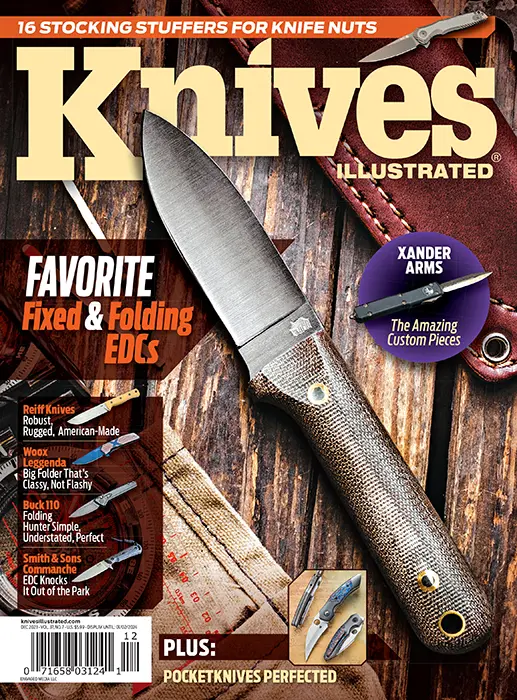 Subscribe / Back Issues
Subscribe / Back Issues